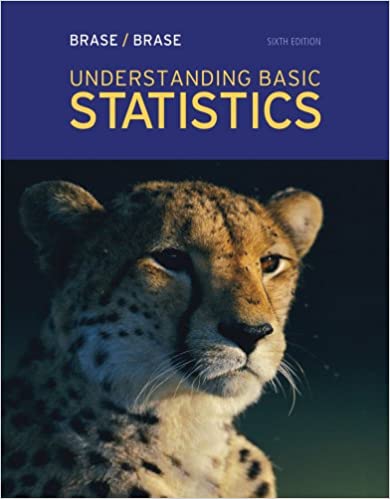
Understanding Basic Statistics 6th Edition by Charles Henry Brase,Corrinne Pellillo Brase
Edition 6ISBN: 978-1111827021
Understanding Basic Statistics 6th Edition by Charles Henry Brase,Corrinne Pellillo Brase
Edition 6ISBN: 978-1111827021 Exercise 67
Provide the following information
(a) What is the level of significance State the null and alternate hypotheses.
(b) Check Requirements What sampling distribution will you use Explain the rationale for your choice of sampling distribution. Compute the value of the sample test statistic.
(c) Find (or estimate) the P -value. Sketch the sampling distribution and show the area corresponding to the P -value.
(d) Based on you answers in part (a) to (c), will you reject or fail to reject the null hypothesis Are the data statistically significant at level
(e) Interpret your conclusion in the context of the application.
Note: For degree of freedom d.f. not given in the Student's t table, use the closest d.f. that is smaller. In some situations, this choice of d.f. may increase the P -value by a small amount and therefore produce a slightly more "conservative" answer.
Wildlife: Coyotes A random sample of 46 adult coyotes in a region of northern Minnesota showed the average age to be
 = 2.05 years, with sample standard deviation s = 0.82 years (based on information from the book Coyotes: Biology, Behavior and Management by M. Bekoff, Academic Press). However, it is thought that the overall population mean age of coyotes is = 1.75. Do the sample data indicate that coyotes in this region of northern Minnesota tend to live longer than the average of 1.75 years Use = 0.01.
= 2.05 years, with sample standard deviation s = 0.82 years (based on information from the book Coyotes: Biology, Behavior and Management by M. Bekoff, Academic Press). However, it is thought that the overall population mean age of coyotes is = 1.75. Do the sample data indicate that coyotes in this region of northern Minnesota tend to live longer than the average of 1.75 years Use = 0.01.
(a) What is the level of significance State the null and alternate hypotheses.
(b) Check Requirements What sampling distribution will you use Explain the rationale for your choice of sampling distribution. Compute the value of the sample test statistic.
(c) Find (or estimate) the P -value. Sketch the sampling distribution and show the area corresponding to the P -value.
(d) Based on you answers in part (a) to (c), will you reject or fail to reject the null hypothesis Are the data statistically significant at level
(e) Interpret your conclusion in the context of the application.
Note: For degree of freedom d.f. not given in the Student's t table, use the closest d.f. that is smaller. In some situations, this choice of d.f. may increase the P -value by a small amount and therefore produce a slightly more "conservative" answer.
Wildlife: Coyotes A random sample of 46 adult coyotes in a region of northern Minnesota showed the average age to be
 = 2.05 years, with sample standard deviation s = 0.82 years (based on information from the book Coyotes: Biology, Behavior and Management by M. Bekoff, Academic Press). However, it is thought that the overall population mean age of coyotes is = 1.75. Do the sample data indicate that coyotes in this region of northern Minnesota tend to live longer than the average of 1.75 years Use = 0.01.
= 2.05 years, with sample standard deviation s = 0.82 years (based on information from the book Coyotes: Biology, Behavior and Management by M. Bekoff, Academic Press). However, it is thought that the overall population mean age of coyotes is = 1.75. Do the sample data indicate that coyotes in this region of northern Minnesota tend to live longer than the average of 1.75 years Use = 0.01.Explanation
(a)
(b)
Since,
this is a right tai...
Understanding Basic Statistics 6th Edition by Charles Henry Brase,Corrinne Pellillo Brase
Why don’t you like this exercise?
Other Minimum 8 character and maximum 255 character
Character 255


